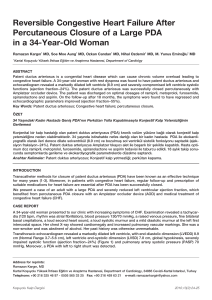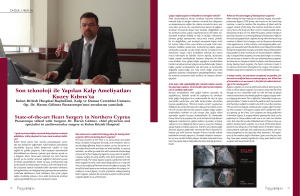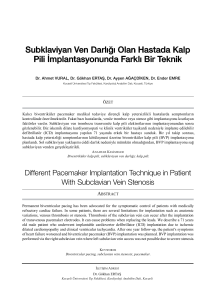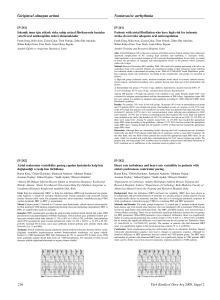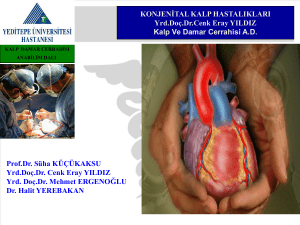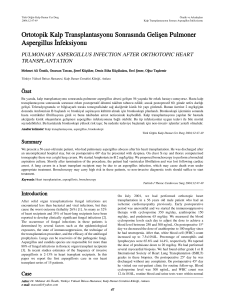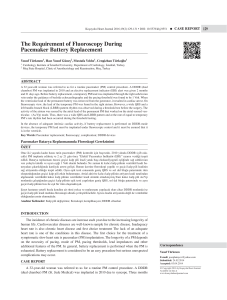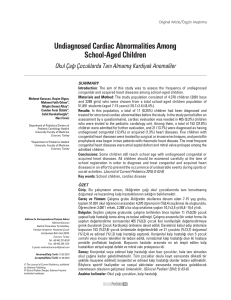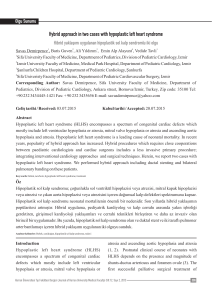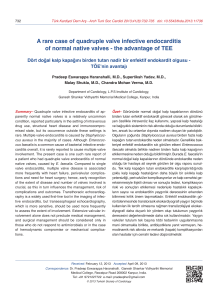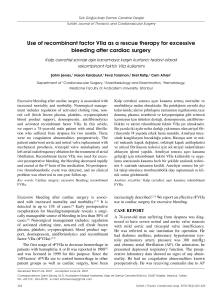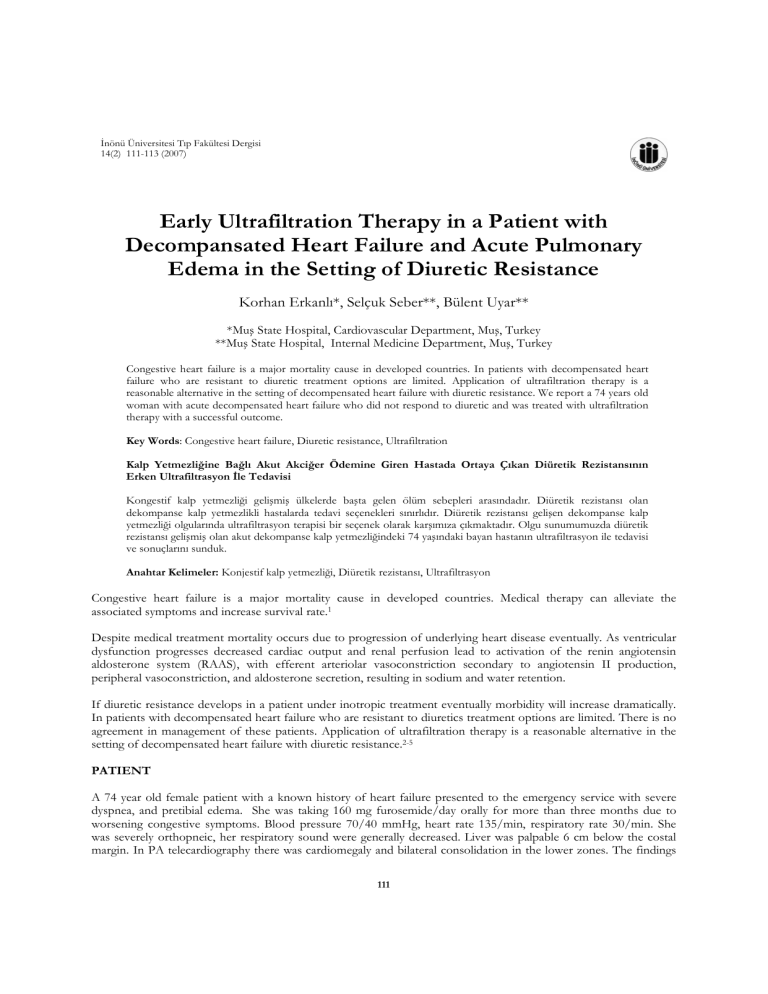
İnönü Üniversitesi Tıp Fakültesi Dergisi
14(2) 111-113 (2007)
Early Ultrafiltration Therapy in a Patient with
Decompansated Heart Failure and Acute Pulmonary
Edema in the Setting of Diuretic Resistance
Korhan Erkanlı*, Selçuk Seber**, Bülent Uyar**
*Muş State Hospital, Cardiovascular Department, Muş, Turkey
**Muş State Hospital, Internal Medicine Department, Muş, Turkey
Congestive heart failure is a major mortality cause in developed countries. In patients with decompensated heart
failure who are resistant to diuretic treatment options are limited. Application of ultrafiltration therapy is a
reasonable alternative in the setting of decompensated heart failure with diuretic resistance. We report a 74 years old
woman with acute decompensated heart failure who did not respond to diuretic and was treated with ultrafiltration
therapy with a successful outcome.
Key Words: Congestive heart failure, Diuretic resistance, Ultrafiltration
Kalp Yetmezliğine Bağlı Akut Akciğer Ödemine Giren Hastada Ortaya Çıkan Diüretik Rezistansının
Erken Ultrafiltrasyon İle Tedavisi
Kongestif kalp yetmezliği gelişmiş ülkelerde başta gelen ölüm sebepleri arasındadır. Diüretik rezistansı olan
dekompanse kalp yetmezlikli hastalarda tedavi seçenekleri sınırlıdır. Diüretik rezistansı gelişen dekompanse kalp
yetmezliği olgularında ultrafiltrasyon terapisi bir seçenek olarak karşımıza çıkmaktadır. Olgu sunumumuzda diüretik
rezistansı gelişmiş olan akut dekompanse kalp yetmezliğindeki 74 yaşındaki bayan hastanın ultrafiltrasyon ile tedavisi
ve sonuçlarını sunduk.
Anahtar Kelimeler: Konjestif kalp yetmezliği, Diüretik rezistansı, Ultrafiltrasyon
Congestive heart failure is a major mortality cause in developed countries. Medical therapy can alleviate the
associated symptoms and increase survival rate.1
Despite medical treatment mortality occurs due to progression of underlying heart disease eventually. As ventricular
dysfunction progresses decreased cardiac output and renal perfusion lead to activation of the renin angiotensin
aldosterone system (RAAS), with efferent arteriolar vasoconstriction secondary to angiotensin II production,
peripheral vasoconstriction, and aldosterone secretion, resulting in sodium and water retention.
If diuretic resistance develops in a patient under inotropic treatment eventually morbidity will increase dramatically.
In patients with decompensated heart failure who are resistant to diuretics treatment options are limited. There is no
agreement in management of these patients. Application of ultrafiltration therapy is a reasonable alternative in the
setting of decompensated heart failure with diuretic resistance.2-5
PATIENT
A 74 year old female patient with a known history of heart failure presented to the emergency service with severe
dyspnea, and pretibial edema. She was taking 160 mg furosemide/day orally for more than three months due to
worsening congestive symptoms. Blood pressure 70/40 mmHg, heart rate 135/min, respiratory rate 30/min. She
was severely orthopneic, her respiratory sound were generally decreased. Liver was palpable 6 cm below the costal
margin. In PA telecardiography there was cardiomegaly and bilateral consolidation in the lower zones. The findings
111
Erkanlı et al
in her initial echocardiography performed in
emergency service were as follows: Left ventricular
end systolic diameter (LVESD): 6,9 mm, Left
ventricular end diastolic diameter (LVEDD): 7,8 mm,
and ejection fraction (EF) was calculated as %15 .
of four days mean blood pressure increased to 90
mmHg, pretibial edema resalved significantly and she
had a normal urine output. No significant electrolyte
changes occurred after ultrafiltration also renal
function remained stabile (serum creatinin values
remained within normal limits). She was extubated at
the eighth day ofadmittance and was discharged from
the hospital at day 14 in good condition.
Initial laboratory values were: Urea 50 mg/dl,
creatinin 0.9 mg/ml, sodium 138 mEq/l, potassium
4.3 mEq/l. Blood gas values: pH: 7.56, CO2 :19, BE:2.4, HCO3:19. Patient was admitted to the intensive
unit. Dobutamin 10 μg/kg/hour and dopamine 3
μg/kg/hour was started. Sufficient response to
diuretic treatment was not observed (120mg ıv bolus
followed by a infusion at a rate of 20mg/hour).
RESULT
In our case acute pulmonary edema due to
decompensated heart failure with in the setting of
diuretic resistance was treated with early ultrafiltration
before renal functions deteriorated and this therapy
resulted in quick recovery of the patient’s
hemodynamic status in an effective way.
6 hours after her admission her dyspnea progressively
increased and acute pulmonary edema developed
soon followed by respiratory failure and cardiac
arrest. She was entubated and cardiopulmonary
resuscitation was performed for 30 minutes until she
was hemodynamically stable.
Although diuretics have a disputable role in
improving survival they do improve symptoms of
congestion effectively and have been a part of
standard congestive heart failure therapy in all recent
trials involving β blockers, angiotensin converting
inhibitors and angiotensin II receptor blockers.6
Diuretic resistance has been independently associated
with total mortality, sudden death and pump failure
death.7
She was followed for 12 hours with inotropic support
and continuous diuretic infusion while mechanically
ventilated. In order to increase the mean arterial
pressure the infusion dose of inotropic agents were
increased as follows: adrenaline 0.2 μg/kg/min,
noradrenaline 0.5 μg/kg/dk, dobutamine 50
μg/kg/hour and dopamine 3 μg/kg/hour. Although
the patient’s mean arterial pressure raised to a level of
60-70 mmHg there was still no urine output. Due to
concomitant presence of volume overload and
oligouria refractory to diuretic treatment intermittent
venous ultrafiltration was planned which would allow
reduction of fluid overload without disturbing
hemodynamics and electrolyte balance. Laboratory
values before ultrafiltration were as follows: Urea 80
mg/dl, creatinin 1.7 mg/dl, Na 125 mEq/l and K 4.4
mEq/l. Size 11F double lumen dialysis catheter was
placed through the femoral vein. High flux
ultrafiltration system was used during ultrafiltration
(Gambro FH 66, Polyamide 0.60 m2, high
flux).Because the patient had a low blood pressure
blood flow rate was held at 140 ml/min. She was
heparinized during the procedure (5 IU/kg/hour).
In moderate to severe heart failure patients diuretic
resistance occurs frequently and often becomes a
clinical challenge. As in our case, the main reason
responsible for this phenomenon is decreased renal
perfusion due to low cardiac output which leads to
decreased sodium delivery to the loop of Henle.8
Because natriuretic activity of loop diuretics is related
to the amount of sodium concentration in this
segment of the nephron, their effectiveness is largely
diminished in this clinical setting. Furthermore in the
setting of acute decompensated heart failure
overactivation of the RAAS may largely blunt the
natriuretic function of the loop diuretics.9
Ultrafiltration removes excess fluid from the patient
without causing electrolyte balance. This results in a
reduction in intravascular volume and ventricular
filling pressures.10 Due to reduction in intravascular
volume oncotic pressure increases and extravascular
volume is drawn into vascular bed11. In addition, due
to reduction in right atrial pressure pulmonary blood
flow decreases which leads to a decrease in
pulmonary venous pressure.12-13
During the ultrafiltration procedure Gambro
hemodiasol solution was used for replacement for
plasma that was drawn. Ultrafiltration was repeated
consecutively for four days, and 3 l of fluid was
drawn at every time ( a total of 12 L of fluid was
drawn ). At the follow up urine output increased with
the use of diuretics and therefore ultrafiltration was
no longer needed and therefore stopped. At the end
Ultrafiltration, besides improving the outcome of
pulmonary edema, increases diuretic sensitivity and as
112
Early Ultrafiltration Therapy in a Patient with Decompansated Heart Failure and Acute Pulmonary Edema in the Setting of Diuretic
Resistance
a result renal compensatory mechanisms begin to
work effectively.
3.
When high dose diuretics and ultrafiltration are
compared in means of returning the patient into
euvolemic state, ultrafiltration has the advantage of
having a rapid effect of reversing pulmomary edema
without effecting neurohumoral activity adversely.14
4.
5.
6.
7.
As our case demonstrates ultrafiltration gives
clinicians an alternative choice for treating patients
with acute decompensated heart failure with
pulmonary edema not responding to diuretics under
inotropic support.15
Early ultrafiltration before
occurrence of impairment in renal function enables
quick recovery of the impaired hemodynamic system
and decreases hospitalization period. We believe that
in the near future ultrafiltration will be used more
often as the results of ongoing trials would
demonstrate that it is a predictable, safe and effective
method for reducing fluid overload.
8.
9.
10.
11.
12.
13.
14.
15.
REFERENCES
ultrafiltration device as a treatment strategy for diureticresistant, refractory heart
failure: initial clinical experience in a single center. J Card Fail 2006 ;12(9):707-14.
Simpson IA, Rae AP, Simpson K , Gribben J, Boulton Jones JM, Allison ME, Hutton
I. Ultrafiltration in the management of refractory congestive heart failure. Br Heart J
1986;55: 344–7.
Hill JA, Yancy CW, Abraham WT. Beyond diuretics: management of volume
overload in acute heart failure syndromes. Am J Med 2006 Dec;119(12 Suppl 1):3744.
Cipolla CM, Grazi S, Rimondini A, Susini G, Guazzi M, Della Bella P, Guazzi MD.
Changes in circulating norepinephrine with hemofiltration in advanced congestive
heart failure. Am J Cardiol 1990; 66: 987–94.
Packer M, Cohn JN, Abraham WT. Consensus recommendations for the
management of chronic heart failure. Am J Cardiol 1999;83:1–38
Neuberg GW, Miller AB, O'Connor CM, Belkin RN, Carson PE, Cropp AB, Frid DJ,
Nye RG, Pressler ML, Wertheimer JH, Packer M; PRAISE Investigators. Prospective
Randomized Amlodipine Survival Evaluation. Diuretic resistance predicts mortality in
patients with advanced heart failure. Am Heart J 2002 ;144(1):31-8.
Knauf H, Mutschler E. Functional state of the nephron and diuretic dose-responserationale for low-dose combination therapy. Cardiology 1994;84(suppl 2):18-26.
Schrier RW. Water and sodium retention in edematous disorders: role of vasopressin
and aldosterone. Am J Med 2006;119(7 Suppl 1):47-53.
Costanzo MR. The role of ultrafiltration in the management of heart failure. Curr
Treat Options Cardiovasc Med 2006;8(4):301-9.
Laine GA, Allen SJ, Katz J, Gabel JC, Drake RE. Effect of systemic venous pressure
elevation on lymph flow and lung edema formation. J Appl Physiol 1986;61:1634–8.
Charman NB, Turk GM, Hey DH. Effect of increased bronchial venous pressure on
lung lymph flow. J Appl Physiol 1985;59:1249–53.
Gaynor SL, Maniar HS, Bloch JB, Steendijk P, Moon MR. Right atrial and ventricular
adaptation to chronic right ventricular pressure overload. Circulation 2005;112(9
Suppl):I212-8.
Ellison DH. Diuretic therapy and resistance in congestive heart failure.Cardiology
2001;96(3-4):132-43.
Sayın T, Koçum T, Akyürek Ö, Kılıçkap M, Özenci M . Yüksek doz diüretik tedaviye
dirençli son dönem konjestif kalp yetmezlikli olgularda intermitan venö-venöz
hemofiltrasyon tedavisi sonuçlarimiz . MN-Kardiyoloji Dergisi 2001;8(1):48-50
Corresponding Author:
Dr. Korhan ERKANLI
Mus State Hospital, MUS, TURKEY
Telephone: 436 212 06 75
Fax
: 436 212 26 85
Email
: [email protected]
1. Swedberg K. Diagnostic and Therapeutic Algorithms in Chronic Heart Failure. Herz
2006;31(9):877-80.
2. Liang KV, Hiniker AR, Williams AW, Karon BL, Greene EL, Redfield
MM.Silverstein ME, Ford CA, Lysaght MJ, Henderson LW. Use of a novel
113

